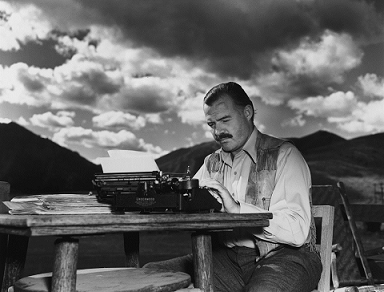AUTHOR PROFILE of Ernest Miller Hemingway
|
Profile by Katie Warczak
Katie Warczak is a graduate student at the Pennsylvania State University specializing in American literature. She is a Graduate Research Assistant for the Hemingway Letters Project and was previously a Junior Research Fellow at the Newberry Library in Chicago. |
Why did he write?
Hemingway wrote as a way to get to the heart of life experiences and express them in an accurate manner. This belief, combined with his experience as a journalist, helped shape the short, to-the-point, yet profound, writing style for which he is known.
What other creative activities was he involved in?
Hemingway dabbled with poetry in addition to prose, but rarely published his poems after the 1920s. Additionally, the author had a lifelong appreciation for fine art and while he did not paint himself, Hemingway was a great admirer of artists such as Pablo Picasso, Joan Miró, and Paul Cézanne.
Who was his favorite author and why?
Hemingway admired a number of writers, but he was too competitive to have a favorite. However, he was very well read. He regularly recommended Mark Twain’s The Adventures of Huckleberry Finn, Rudyard Kipling, Stephen Crane, Fyodor Dostoyevsky, James Joyce, Henry James’s short stories, Guy de Maupassant, Gustave Flaubert, Stendhal, and Thomas Mann. [1] He also had an extensive library and appreciated Shakespeare, John Donne, Ezra Pound’s Cantos, David Garnett, Archibald MacLeish, Gertrude Stein’s early works, Marjorie Kinnan Rawlings, Dawn Powell, and Dorothy Parker.
Tell us about the mechanics of how he wrote.
Careful and measured writing (he would count how many words he had written in a day) with rewriting once he was done. He would sometimes ask the advice of other writers, such as John Dos Passos, but generally loathed editorial interference. One of the reasons he initially enjoyed working with Arnold Gingrich, the editor of Esquire magazine, was the promise that Gingrich would not try to edit Hemingway’s work.(2)
Finally, what did he think about Carp, the fish, if anything at all?
Although Hemingway’s father inspired a lifelong passion for fishing in his son, carp were not part of Hemingway’s fishing routine. In his youth, he preferred the trout and bass available near Windemere, his family’s house on Walloon Lake in Michigan, and later in life fished for saltwater species such as marlin, sailfish, billfish, and tuna. This later fishing not only pleased Hemingway, but helped the Academy of Natural Sciences better understand the behavior of marlin, tuna, and other saltwater game fish.(3) As a result of his commitment to, and promotion of, deep sea fishing through his writing as well as his record catches, Hemingway earned the position of Vice President of the International Game Fish Association (IGFA). He held this title from 1940 until his death and was inducted into the IGFA Hall of Fame in 1998. (4)
Footnotes
1 Brasch, James, and Joseph Sigman. Hemingway’s Library, pp. 17-18.
2 Baker, Carlos. Ernest Hemingway: A Life Story. Scribner’s, 1969, p. 244.
3 Chakrabarty, Prosanta. “Papa’s Fish: A Note on Neomerinthe Hemingwayi.” The Hemingway Review, vol. 25, no. 1, 2005, p. 109.
4 “Ernest Hemingway.” International Game Fish Association.
1 Brasch, James, and Joseph Sigman. Hemingway’s Library, pp. 17-18.
2 Baker, Carlos. Ernest Hemingway: A Life Story. Scribner’s, 1969, p. 244.
3 Chakrabarty, Prosanta. “Papa’s Fish: A Note on Neomerinthe Hemingwayi.” The Hemingway Review, vol. 25, no. 1, 2005, p. 109.
4 “Ernest Hemingway.” International Game Fish Association.

